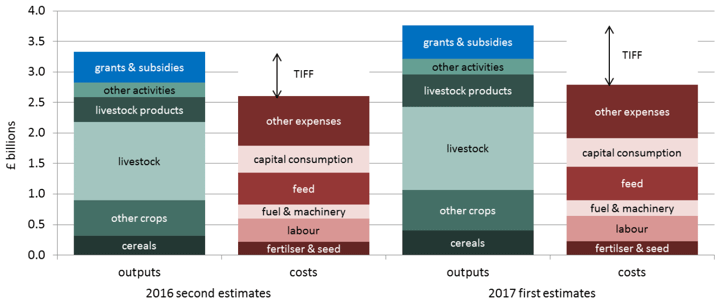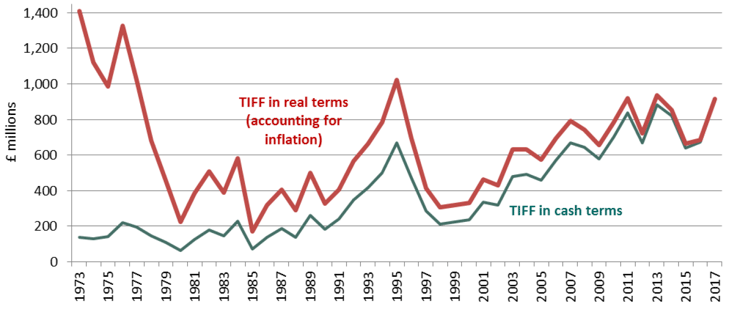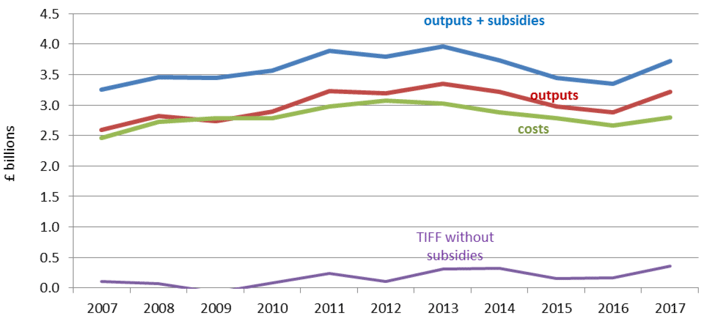Total income from farming: estimates for Scotland 2015-2017
The official measure of the net income gained by the agriculture industry in Scotland.
3. Overview of TIFF 2016 and 2017
Chart 1 gives a summary of the make-up of outputs and costs within TIFF. Gross outputs were £2.8 billion in 2016, rising to an estimated £3.2 billion in 2017, total costs rose from £2.6 billion in 2016 to £2.8 billion in 2017, with subsidies rising from £467 million in 2016 to £506 million in 2017. The differences between income (outputs plus subsidies) and costs give the overall estimates of TIFF.
With more data for 2016 now available, last year's initial estimate for TIFF has been revised downwards to £672 million. The 2016 estimate is up £33 million on 2015; that's an increase of five per cent, or three per cent after accounting for inflation.
The initial estimate for 2017 is £917 million, an increase of £245 million on 2016, 36 per cent, or 34 per cent in real terms. Outputs are estimated to have risen faster than costs, with large rises seen in milk (up £117m) and barley (up £67m), both mainly due to improved prices.
The data show that the profitability of the agricultural sector is heavily, though not entirely, dependent upon subsidies, with subsidies accounting for 60 per cent of TIFF. In 2017, the original amount of pillar 1 EU support increased five per cent (€24 million), but the weakening of the pound resulted in an eight per cent increase in overall support payments.
Tables showing the detailed list of components of TIFF are provided in section 12, with data from 2007 to 2016. Chart 1 illustrates the components that make up the calculation of TIFF, with TIFF being the difference between total outputs (plus subsidies) and total costs.
Chart 1: Make-up of Agricultural Accounts, 2016 and 2017 source: Table 1

3.1 Long term trends
The long term trend, illustrated in Chart 2, inevitably includes some jumps in individual elements where a particular methodology has changed and it has not been possible or preferable to recalculate the time-series back to 1973. However these individual discontinuities are considered small enough relative to the overall pattern of changes in TIFF.
In real terms (once inflation has been accounted for), high inflation in the mid-1970s resulted in a large fall in TIFF. TIFF then almost trebled between 1990 and 1995 before falling from 1995 to 1998 primarily due to a strong pound, weak world commodity prices and the impact of BSE. The outbreak of Foot and Mouth Disease in 2001 appears to have had little impact on TIFF. The real terms value of TIFF then almost trebled between 1998 and 2013, showing consistent steady growth, though fluctuating every few years.
Chart 2: Trends in Total Income from Farming ( TIFF), 1973 to 2017 source: Table 4

3.2 High-level components of TIFF
Total outputs from farms in Scotland fell from £2.86 billion in 2015 to £2.82 billion in 2016. Once inflation is taken into account this was a decrease of three per cent. The first estimates for 2017 suggest an increase of £390 million to £3.21 billion, or a real terms increase of 12 per cent.
Total costs for farms in Scotland fell from £2.67 billion in 2015 to £2.62 billion in 2016. Once inflation is taken into account this was a fall of four per cent. The first estimates for 2017 suggest an increase of £184 million to £2.80 billion, or a real terms increase of five per cent.
Chart 3 shows that outputs and costs have been broadly similar across the last ten years, with outputs slightly higher than costs in nine of the last ten years, and more clearly so since 2013.
Subsidies and other payments are mainly affected by changes in the euro exchange-rate, though until recently there had also been significant reductions in the euro payment amount. However, in the last two years receipt of convergence payments have resulted in an increase in the budgeted euro amount of direct payments, though once deductions and penalties are applied this does not always result in increased payments. This meant that in 2016 total payments (excluding coupled support) increased by £16 million to £467 million, a one per cent increase after accounting for inflation, and an increase of £39 million in 2017 to £506 million, a six per cent increase after accounting for inflation.
Total grants, subsidies and coupled support, as a proportion of TIFF, has fallen from 89 per cent in 2010 to an estimated 60 per cent in 2017. The last time that TIFF would have been negative without subsidies was in 2009.
Chart 3: Trends in outputs, costs and subsidies over the period, in real terms source: Table 3

Contact
There is a problem
Thanks for your feedback